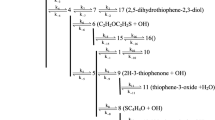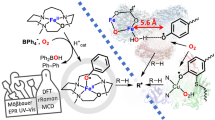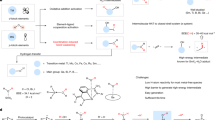Abstract
ALTHOUGH it has been known for a long time that phenols inhibit the autoxidation of many organic substances, the exact nature of the inhibition process is still not completely understood1. Most experimental evidence suggests that the reaction involves a straightforward abstraction of the phenolic hydrogen by the substrate peroxy radicals to give a hydroperoxide and a comparatively unreactive phenoxy radical:  However, several workers have shown that replacement of the phenolic hydrogen by deuterium has either no effect, or else only a comparatively small effect (∼ 0–60 per cent) on the rate of this reaction1–3. It has therefore been suggested that the rate-determining step involves the prior formation of a complex between the peroxy radical and the phenol followed by a rapid, non-rate determining, hydrogen abstraction1,2. Alternatively, small isotope effects could be secondary effects or could arise in abstraction from the activated complex3. We have now found that the apparent smallness or complete absence of the expected isotope effect is most probably due to the very rapid exchange that occurs between a deuterated phenol dissolved in an organic substrate and traces of moisture or the hydroperoxide products of oxidation. The oxidation of cumene under 760 mm. of oxygen initiated by α,α′-azo-bis-isobutyronitrile (AIBN) was studied in a conventional constant pressure apparatus. The oxidation was partially inhibited by 2,6-di-tert-butyl-4-methylphenol (BMP). In the presence of this inhibitor the initial rate is quite low, but it rises to the rate of the uninhibited reaction as soon as the inhibitor is consumed. This initial rate is proportional to the AIBN concentration and inversely proportional to the BMP concentration, and its reciprocal is proportional to the rate of reaction 1. We have found that exchange can be partially suppressed by using rather high concentration of deuterated BMP and that under these conditions a fairly large isotope effect is observed which increases as the inhibitor concentration is increased. For example, some preliminary experiments at 70° C, with an AIBN concentration of 0.34 mole/1. gave measured isotope effects of 1.6, 1.8 and 2.2 at BMP concentrations of 10−2, 2 × 10−2 and 4 × 10−2 moles/l. respectively. Theoretically, the true isotope effect in the absence of exchange could be obtained by extrapolating to infinite inhibitor concentration. A simpler and, probably, much more accurate procedure is to add an excess of deuterium oxide to the reaction system (∼ 1.0 c.c. D2O to 5 c.c. cumene), thereby maintaining the BMP in its fully deuterated state throughout the early part of the reaction in which the rates are measured. Fig. 1 shows some results obtained in this way at 65° C. with an AIBN concentration of 0.327 mole/l. and a BMP concentration of 10−2 moles/l. In the presence of deuterium oxide the initial rate is ≥4.2 times that obtained with the undeuterated inhibitor, whereas, in the absence of deuterium oxide, this factor was only 2.3. That is, from the average of three determinations, the true deuterium isotope effect for reaction 1 between cumyl peroxy radicals and BMP at 65° C. is ≥4.2 ± 0.5. Our assumption that the major, and possibly only, part played by the deuterium oxide is to maintain the BMP in its fully deuterated state is confirmed by the fact that water has no appreciable effect on the undeuterated inhibitor (see Fig. 1) and that the effects of water and deuterium oxide on the uninhibited oxidation are very small. Experiments of a similar nature using styrene as the substrate gave an isotope effect of about 10.6 at 65° C.
However, several workers have shown that replacement of the phenolic hydrogen by deuterium has either no effect, or else only a comparatively small effect (∼ 0–60 per cent) on the rate of this reaction1–3. It has therefore been suggested that the rate-determining step involves the prior formation of a complex between the peroxy radical and the phenol followed by a rapid, non-rate determining, hydrogen abstraction1,2. Alternatively, small isotope effects could be secondary effects or could arise in abstraction from the activated complex3. We have now found that the apparent smallness or complete absence of the expected isotope effect is most probably due to the very rapid exchange that occurs between a deuterated phenol dissolved in an organic substrate and traces of moisture or the hydroperoxide products of oxidation. The oxidation of cumene under 760 mm. of oxygen initiated by α,α′-azo-bis-isobutyronitrile (AIBN) was studied in a conventional constant pressure apparatus. The oxidation was partially inhibited by 2,6-di-tert-butyl-4-methylphenol (BMP). In the presence of this inhibitor the initial rate is quite low, but it rises to the rate of the uninhibited reaction as soon as the inhibitor is consumed. This initial rate is proportional to the AIBN concentration and inversely proportional to the BMP concentration, and its reciprocal is proportional to the rate of reaction 1. We have found that exchange can be partially suppressed by using rather high concentration of deuterated BMP and that under these conditions a fairly large isotope effect is observed which increases as the inhibitor concentration is increased. For example, some preliminary experiments at 70° C, with an AIBN concentration of 0.34 mole/1. gave measured isotope effects of 1.6, 1.8 and 2.2 at BMP concentrations of 10−2, 2 × 10−2 and 4 × 10−2 moles/l. respectively. Theoretically, the true isotope effect in the absence of exchange could be obtained by extrapolating to infinite inhibitor concentration. A simpler and, probably, much more accurate procedure is to add an excess of deuterium oxide to the reaction system (∼ 1.0 c.c. D2O to 5 c.c. cumene), thereby maintaining the BMP in its fully deuterated state throughout the early part of the reaction in which the rates are measured. Fig. 1 shows some results obtained in this way at 65° C. with an AIBN concentration of 0.327 mole/l. and a BMP concentration of 10−2 moles/l. In the presence of deuterium oxide the initial rate is ≥4.2 times that obtained with the undeuterated inhibitor, whereas, in the absence of deuterium oxide, this factor was only 2.3. That is, from the average of three determinations, the true deuterium isotope effect for reaction 1 between cumyl peroxy radicals and BMP at 65° C. is ≥4.2 ± 0.5. Our assumption that the major, and possibly only, part played by the deuterium oxide is to maintain the BMP in its fully deuterated state is confirmed by the fact that water has no appreciable effect on the undeuterated inhibitor (see Fig. 1) and that the effects of water and deuterium oxide on the uninhibited oxidation are very small. Experiments of a similar nature using styrene as the substrate gave an isotope effect of about 10.6 at 65° C.
This is a preview of subscription content, access via your institution
Access options
Subscribe to this journal
Receive 51 print issues and online access
$199.00 per year
only $3.90 per issue
Buy this article
- Purchase on Springer Link
- Instant access to full article PDF
Prices may be subject to local taxes which are calculated during checkout
Similar content being viewed by others
References
Ingold, K. U., Chem. Rev., 61, 563 (1961).
Hammond, G. S., Boozer, C. E., Hamilton, C. E., and Sen, J. N., J. Amer. Chem. Soc., 77, 3238 (1955).
Boozer, C. E., and Snead, C. C. (private communication).
Author information
Authors and Affiliations
Rights and permissions
About this article
Cite this article
INGOLD, K., HOWARD, J. Reaction of Phenols with Peroxy Radicals. Nature 195, 280–281 (1962). https://doi.org/10.1038/195280b0
Issue Date:
DOI: https://doi.org/10.1038/195280b0
This article is cited by
Comments
By submitting a comment you agree to abide by our Terms and Community Guidelines. If you find something abusive or that does not comply with our terms or guidelines please flag it as inappropriate.



